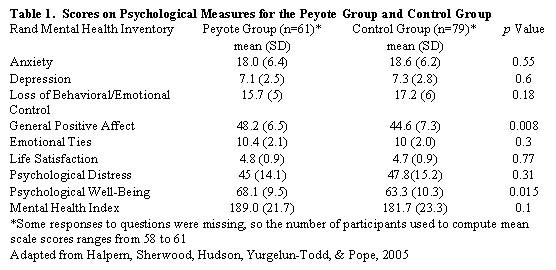The STASH Vol. 3(6) – Sufferin’ succulents!? Lack of residual psychological effects from peyote use
Peyote is a small, spineless cactus containing the hallucinogen mescaline. The Native American Church (NAC) expects members to abstain from any drug or alcohol use except peyote, which is taken only during religious ceremonies (Stewart, 1987). This circumstance creates a unique opportunity to study the psychological effects of long-term peyote use, without confounding effects from additional drug use. This week’s STASH reviews just such a study conducted on a sample of Navajo Native Americans.
Halpern, Sherwood, Hudson, Yurgelun-Todd, and Pope (2005) recruited 61 Navajo NAC members with a history of extensive ritual use of peyote (i.e., ingested peyote at least 100 times) and 79 Navajos who report minimal use of peyote, alcohol or other substance use. Researchers excluded people with a history of psychological disorders or head injury, those who self-reported illicit substance use other than peyote, and people with other markers of severe illness. Researchers use multiple linear regression to adjust for age and gender so they could properly compare the peyote users to the control group on non-users. Table 1 presents the comparison for measures from the Rand Mental Health Inventory.
Figure. Click image to enlarge.
There were no differences between study groups on demographic characteristics. The mean age of all study participants was approximately 30 years, and the majority of study participants were female and middle class. More than half of the sample had a high school education or less. Of the people contacted for the peyote and control groups, 12% did not meet inclusion criteria. The peyote group evidenced significantly more general positive affect and psychological well-being than the control group. For none of the measures were the peyote users less mentally healthy than the control group.
This study has some limitations. First, retrospective self-report of drug use is subject to self-presentation biases. For example, some participants might have underreported prior drug or alcohol use for fear of legal sanctions. Second, the peyote users belonged to a religious community and the control group did not. Therefore the increase in metal health of the peyote group might have been due to the effects of belonging to such a community. Furthermore, members of the community who might have experienced negative psychological effects from peyote might have been more likely to stop using it or not to enroll in the study; thus, these people were not included in the experimental group Also, all study participants were recruited with the assistance of a Navajo case finder so they might not be representative of this Navajo community. Third, because of the unique cultural characteristics of this sample, researchers cannot generalize study findings to other populations of peyote users or users of other types of hallucinogens (e.g., LSD).
Despite these limitations, this study demonstrates an absence of any peyote-related adverse psychological effects among a sample of Navajo Native Americans who were taking the drug within the context of religious ceremony.
What do you think? Please use the comment link below to provide feedback on this article.
References
Halpern, J. H., Sherwood, A. R., Hudson, J. I., Yurgelun-Todd, D., & Pope, H. G. (2005). The psychological and cognitive effects of long-term peyote use among Native Americans. Biological Psychiatry, 58, 624-631.
Stewart, O. (1987). Peyote religion: A history. Tulsa: University of Oklahoma Press.
